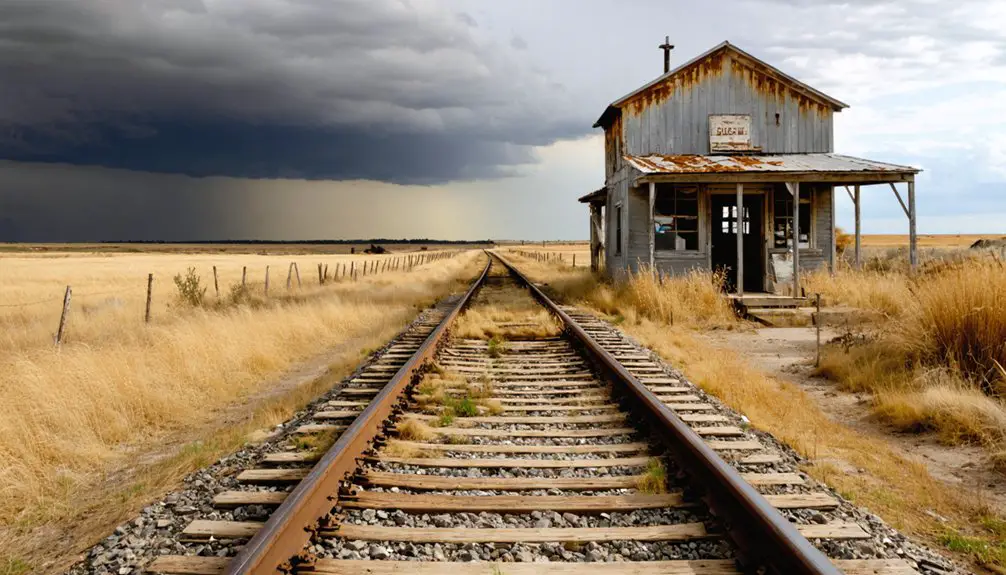You’ll find Cohn, Oklahoma located nine miles south of Talihina in Pushmataha County, where it originated as an essential railway stop and gravel quarry operation. William Cohn established the quarry to serve the St. Louis and San Francisco Railway, creating a dedicated rail spur for loading materials. The site became a strategic transportation hub between 1907 and 1917, connecting three major rail networks before declining into one of Oklahoma’s estimated two thousand ghost towns. The quarry’s remains tell a fascinating story of early Oklahoma’s industrial development.
Key Takeaways
- Cohn was established as a small Oklahoma settlement near Talihina in Pushmataha County during the late 19th or early 20th century.
- The town primarily served as a rail transportation hub with specialized switching yards and loading facilities for freight operations.
- William Cohn established a significant gravel quarry that supplied materials to the St. Louis and San Francisco Railway.
- Three major rail networks converged at Cohn, making it a crucial logistics center for coal, oil, and agricultural products.
- By the mid-20th century, Cohn became one of Oklahoma’s estimated two thousand ghost towns following modernization of rail transport.
The Origins and Location of Cohn
Cohn emerged as a small Oklahoma settlement during the state’s early period of economic expansion, likely established in the late 19th or early 20th century.
You’ll find that Cohn’s history aligns with the dynamic wave of town development that swept across Oklahoma during this transformative era.
The town’s location played a vital role in its initial establishment, positioned within Oklahoma’s evolving landscape where economic factors drove rapid community growth. Like many settlements, economic booms and busts shaped the town’s trajectory.
While the exact origin of Cohn’s name isn’t certain, it’s believed to have connections to an influential founding family or local entrepreneur.
Like many Oklahoma settlements of its time, Cohn’s placement near natural resources and transportation corridors reflected the practical considerations that shaped early town development in the region’s pre-statehood and early statehood periods. The settlement may have been one of the state’s estimated two thousand ghost towns that emerged during Oklahoma’s development.
Railroad Operations and Transportation Hub
When you look at Cohn’s early railroad operations, you’ll find specialized switching yards and loading facilities designed to connect with the Oklahoma Central Railroad’s 127-mile mainline between Lehigh and Chickasha.
The area’s loading operations supported diverse freight including coal from nearby mines, cotton products, and livestock that traveled through the OCR’s connection with the Santa Fe system at Purcell. The railway served multiple communities including Byars and Stratford along its route.
As part of the broader rail network serving southern Oklahoma between 1907 and 1917, Cohn’s rail facilities helped integrate local commerce with major transportation corridors that moved goods across the territory. After the railroad was reorganized in 1914, it operated under the control of the Atchison, Topeka and Santa Fe Railway.
Switch and Loading Operations
Located along the St. Louis and San Francisco Railway line, Cohn served as a strategic switch point that maximized operational flexibility in southeastern Oklahoma.
You’d find this site, positioned nine miles south of Talihina, efficiently managing rail traffic through advanced switching techniques and loading efficiency protocols.
The site’s core operations included:
- Managing track changes for both mainline and siding movements
- Loading bulk materials, primarily gravel from William Cohn’s quarry
- Coordinating freight car distributions across the regional network
- Facilitating resource transfers between local industries and broader markets
The area’s operations were overseen by several members of the Kohenitic surname families who maintained the railway facilities.
While Cohn never developed into a commercial center, its specialized infrastructure supported crucial freight operations within the SLSF system.
The site’s focused purpose exemplified the railway’s commitment to maintaining essential logistical nodes throughout former Choctaw Nation territory.
The facility played a vital role in the region’s dense branch network that emerged between 1897 and 1907.
Rail Transport Logistics
Three major rail networks converged to establish Cohn’s prominence as a strategic transportation hub in southeastern Oklahoma during the late 1890s.
You’d find continuous freight transportation operations connecting resource extraction sites to major markets, with Cohn serving as an essential transfer point.
The region’s railway expansions, particularly after the Rock Island System’s acquisition of the Choctaw, Oklahoma & Gulf Railroad in the early 1900s, transformed this location into a critical logistics center.
The development mirrored the broader trend of rail line growth across Oklahoma, which reached six thousand miles by 1910.
The hub’s efficiency stemmed from its role in coordinating multiple train schedules and facilitating cargo transfers between lines.
You’ll understand how Cohn’s position along established trade routes made it an ideal collection and redistribution point for coal, oil, and agricultural products moving through Indian Territory.
William Cohn’s Quarry Legacy
As the namesake of Cohn, Oklahoma, William Cohn established an essential gravel quarry operation that served the St. Louis and San Francisco Railway during the late 19th and early 20th centuries.
His quarry operations left a lasting impact on regional development through:
- Providing critical gravel supplies for railroad bed maintenance and construction
- Creating a dedicated rail spur that connected directly to the main railway line
- Establishing a strategic loading point that became known as Cohn
- Supporting local infrastructure development beyond just railroad needs
Similar to how the geological resources management principles guide modern quarry operations, Cohn’s extraction methods helped establish sustainable practices for the region.
While the Cohn legacy didn’t result in a permanent settlement, his quarry played a crucial role in Oklahoma’s early industrial growth.
The site’s brief but significant contribution to railway expansion reflects the dynamic nature of resource-based enterprises in early Oklahoma’s development.
Like many controversial figures in American industry, Cohn’s business practices drew both praise and criticism from his contemporaries.
Life in the Choctaw Nation Territory
When the Treaty of Dancing Rabbit Creek took effect in 1830, the Choctaw Nation ceded their ancestral Mississippi lands in exchange for 13 million acres in southeastern Oklahoma’s Indian Territory.
Between 1831 and 1833, over 11,000 Choctaws relocated, establishing scattered farms rather than traditional village settlements. You’d find the nation divided into three districts – Moshulatubbee, Pushmataha, and Apukshunnubbee – with commercial centers like Boggy Depot, Doaksville, and Skullyville serving as crucial hubs.
The Choctaw resettlement saw 11,000 people adapting to new lands through scattered farming and organized districts with vital trading centers.
Choctaw culture adapted while maintaining core traditions. The tribal governance evolved from a three-chief system to a bicameral legislature by 1843, though this sovereignty wouldn’t last.
Federal interventions, including the Dawes Act and Curtis Act, gradually eroded tribal authority until 1906, when the government fully dissolved Choctaw self-rule.
The Rise and Decline of a Railway Stop

In the early 1900s, you’d find Cohn emerging as a strategic railway switch and loading point along the St. Louis and San Francisco Railway, where William Cohn’s gravel quarry operations established the town’s primary industrial function.
You could witness freight cars regularly stopping at the location, approximately nine miles south of Talihina in Pushmataha County, as workers loaded quarried materials for transport throughout the region.
The site’s industrial activity gradually diminished as rail transport modernized, leading to Cohn’s eventual abandonment and transformation into one of Oklahoma’s ghost towns by the mid-20th century.
Railroad’s Impact on Cohn
Through the establishment of the Oklahoma Central Railway in 1904, Cohn emerged as an important railway stop along the 127-mile line stretching from Lehigh to Chickasha.
The railroad’s influence transformed this small Oklahoma town into a bustling transportation hub, where economic transformation took hold through various commercial activities.
You’ll find Cohn’s railway legacy defined by these key developments:
- Served as a crucial stop for coal transport from Lehigh mines to Purcell
- Facilitated the movement of cotton, livestock, and building materials
- Connected local merchants to broader markets through freight services
- Provided passenger service until mixed trains replaced dedicated routes in 1908
Gravel Quarry Loading Operations
Operating alongside the St. Louis and San Francisco Railway, Cohn’s gravel quarry served as an essential loading point about nine miles south of Talihina.
You’d find workers managing rail car switches as they coordinated gravel extraction and loading operations to meet the railway’s constant demand for track ballast.
The quarry’s loading techniques reflected early 20th-century practices, with laborers primarily relying on manual methods and basic mechanical equipment to transfer extracted gravel onto waiting rail cars.
While the site never expanded beyond its core function as a switching and loading stop, it played a significant role in maintaining the region’s rail infrastructure.
The operation’s efficiency depended entirely on its rail connectivity, which allowed quarried materials to reach construction projects throughout Pushmataha County and beyond.
Brief Industrial Legacy
The rise and fall of Cohn, Oklahoma mirrors many short-lived railway stops that dotted the state’s early industrial landscape. Located nine miles south of Talihina in Pushmataha County, this St. Louis and San Francisco Railway stop gained its industrial significance through William Cohn’s gravel quarry operations.
You’ll find Cohn’s brief but impactful story defined by:
- Strategic positioning as a vital loading point for quarry materials
- Direct connection to regional transportation networks
- Dependence on single-industry economics
- Rapid decline when transportation evolution shifted away from rail
While Cohn never developed into a bustling commercial center, its legacy as a railway ghost town represents the freedom and opportunity that railway expansion brought to early Oklahoma, even if that promise proved temporary for many such industrial outposts.
Preserving Cohn’s Historical Memory

Since Cohn’s disappearance as a functioning railroad settlement, preservation efforts have focused on documenting its brief but significant history through multiple channels.
You’ll find Cohn’s story preserved through the Pushmataha County Historical Society‘s archival records, which capture its role as a railroad switch and gravel loading point. Community engagement initiatives have helped collect oral histories and artifacts, while educational programs now share Cohn’s industrial heritage with younger generations.
The story of Cohn lives on through historical records, community memories, and educational programs highlighting its railroad legacy.
Digital archives and interactive maps make Cohn’s history accessible to anyone interested in Oklahoma’s ghost towns.
Archaeological surveys document the remaining physical evidence, while scholarly research incorporating over 1,200 sources guarantees that Cohn’s contribution to regional development won’t be forgotten. The surrounding landscape itself serves as a proof of the town’s quarrying operations.
Frequently Asked Questions
What Happened to the Original Railroad Tracks and Infrastructure at Cohn?
You’d be shocked to see how railroad history vanished – the tracks and infrastructure at this once-bustling spot suffered complete infrastructure decline, with rails removed and facilities abandoned during mid-20th century consolidations.
Are There Any Remaining Physical Structures or Ruins Visible Today?
You won’t find any significant abandoned buildings or historical landmarks at the site today – time and development have erased most physical traces of the former community’s structures and infrastructure.
How Many People Lived in Cohn During Its Peak Period?
You’ll find no exact population records exist, but considering historical significance and population trends of similar Oklahoma ghost towns, Cohn likely peaked between several hundred and a few thousand residents.
What Specific Types of Gravel Were Extracted From Cohn’s Quarry?
You’ll find that Cohn’s quarry operations primarily extracted crushed limestone gravel types, including coarse chips around 1.5 inches, fine screenings under ⅜ inch, and larger riprap stones for erosion control.
Did Any Native American Settlements Exist at This Location Before Cohn?
Like shadows dancing through time, you won’t find direct evidence of permanent Native settlements at Cohn’s exact spot, though both Cherokee and Osage tribes historically moved through this northeastern Oklahoma territory.
References
- https://en.wikipedia.org/wiki/List_of_ghost_towns_in_Oklahoma
- https://www.youtube.com/watch?v=5d-wHDTIbb0
- https://www.okhistory.org/publications/enc/entry?entry=GH002
- https://www.youtube.com/watch?v=aeAXyEw70io
- https://en.wikipedia.org/wiki/Cohn
- https://okmag.com/blog/a-ghostly-site/
- https://www.kosu.org/local-news/2014-05-23/ghost-towns-all-black-oklahoma-towns
- https://en.wikipedia.org/wiki/Oklahoma_Central_Railroad_(1914–1942)
- https://www.abandonedrails.com/oklahoma-central-railway
- http://dougdawg.blogspot.com/2007/08/okc-trains-part-1.html



